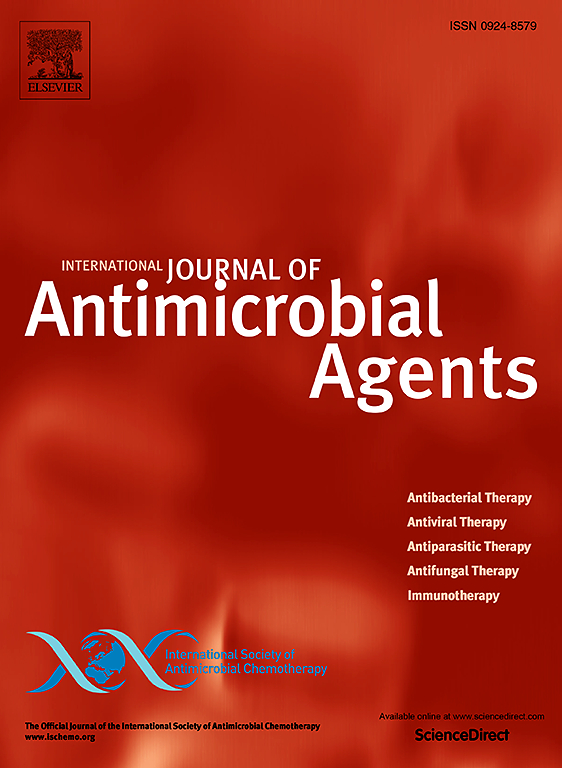Tigecycline modulates LPS-induced inflammatory response in sepsis via NF-κB signalling pathways: Experimental insights into immune regulation
IF 4.9
2区 医学
Q1 INFECTIOUS DISEASES
International Journal of Antimicrobial Agents
Pub Date : 2025-03-24
DOI:10.1016/j.ijantimicag.2025.107496
引用次数: 0
Abstract
Background
Sepsis is associated with high morbidity and high mortality and has strongly motivated intense studies into its mechanisms. Antibiotics, aimed to eradicate bacteria, have some impact on the immune system due to anti-inflammatory properties. Tigecycline, an antibiotic of the glycylcycline class, is commonly used for severe infections.
Purpose
This study aimed to investigate tigecycline's mechanism on the inflammatory response of sepsis to find new targets for sepsis treatment. The objective included (i) to observe the changes in inflammatory factors in LPS (lipopolysaccharide) induced septic mice after tigecycline administration, (ii) to detect the effect of tigecycline on macrophages NF-κB (nuclear factor kappa B) signalling.
Methods
For LPS-induced sepsis in mice and intervention with tigecycline, mice were first injected with tigecycline (6.5 mg/kg) via tail vein followed by LPS (15 mg/kg). Luminex analysis was performed on 16 mediators. NF-κB signalling pathway antibody chip detected the expression of target sites in macrophages of the LPS group and tigecycline + LPS group.
Results
Tigecycline has inhibitory effects on LPS-induced inflammatory response in septic mice, decreasing the concentrations of IL (interleukin)-6, IL-27, TNF-α (tumour necrosis factor-α), TNF RII, IFN-γ (interferon-gamma), CCL5/RANTES (C![]() C Motif Chemokine Ligand) while increasing IL-6Rα, IL-10, and TWEAK (TNF-related weak inducer of apoptosis). Tigecycline downregulated phosphorylation levels of key sites JNK (c-Jun N-terminal kinase)1/2/3, p-p65 (s468) and p-p105/p50 (s907) in NF-κB signalling.
C Motif Chemokine Ligand) while increasing IL-6Rα, IL-10, and TWEAK (TNF-related weak inducer of apoptosis). Tigecycline downregulated phosphorylation levels of key sites JNK (c-Jun N-terminal kinase)1/2/3, p-p65 (s468) and p-p105/p50 (s907) in NF-κB signalling.
Conclusions
Tigecycline may inhibit the excessive immune response induced by LPS in sepsis, which may cause a potential protective effect on the host through immune regulation.

替加环素通过NF-κB信号通路调节lps诱导的脓毒症炎症反应:免疫调节的实验见解。
背景:脓毒症与高发病率和高死亡率有关,并强烈推动了对其机制的深入研究。抗生素旨在消灭细菌,由于其抗炎特性,对免疫系统有一定影响。替加环素是一种甘环素类抗生素,通常用于严重感染。目的:本研究旨在探讨替加环素对脓毒症炎症反应的作用机制,为脓毒症的治疗寻找新的靶点。目的:(1)观察替加环素给药后LPS(脂多糖)诱导的脓毒症小鼠炎症因子的变化;(2)检测替加环素对巨噬细胞NF-κB(核因子κB)信号传导的影响。方法:针对LPS致小鼠脓毒症及替加环素干预,小鼠先经尾静脉注射替加环素(6.5mg/kg),再注射LPS (15 mg/kg)。对16种介质进行Luminex分析。NF-κB信号通路抗体芯片检测LPS组和替加环素 + LPS组巨噬细胞靶位点的表达情况。结果:替加环素对脓毒症小鼠lps诱导的炎症反应具有抑制作用,降低IL(白细胞介素)-6、IL-27、TNF-α、TNF-α、IFN-γ、CCL5/RANTES (C-C Motif趋化因子配体)浓度,增加IL- 6r α、IL-10和TWEAK (TNF相关的凋亡弱诱导因子)浓度。替加环素下调NF-κB信号通路中关键位点JNK (c-Jun n -末端激酶)1/2/3、p-p65 (s468)和p-p105/p50 (s907)的磷酸化水平。结论:替加环素可抑制脓毒症中LPS诱导的过度免疫反应,可能通过免疫调节对宿主产生潜在的保护作用。
本文章由计算机程序翻译,如有差异,请以英文原文为准。
求助全文
约1分钟内获得全文
求助全文
来源期刊
CiteScore
21.60
自引率
0.90%
发文量
176
审稿时长
36 days
期刊介绍:
The International Journal of Antimicrobial Agents is a peer-reviewed publication offering comprehensive and current reference information on the physical, pharmacological, in vitro, and clinical properties of individual antimicrobial agents, covering antiviral, antiparasitic, antibacterial, and antifungal agents. The journal not only communicates new trends and developments through authoritative review articles but also addresses the critical issue of antimicrobial resistance, both in hospital and community settings. Published content includes solicited reviews by leading experts and high-quality original research papers in the specified fields.

 求助内容:
求助内容: 应助结果提醒方式:
应助结果提醒方式:


